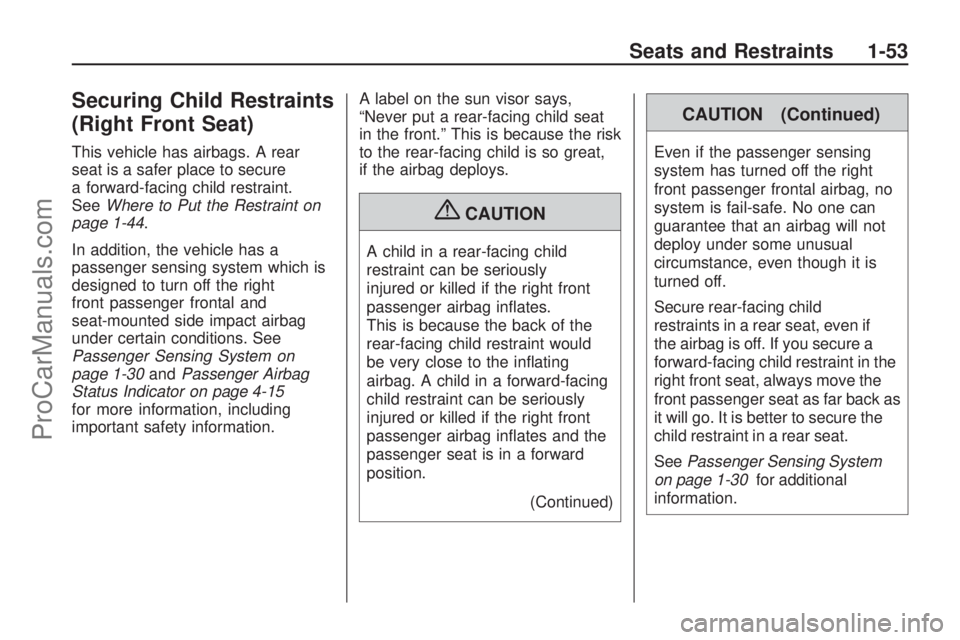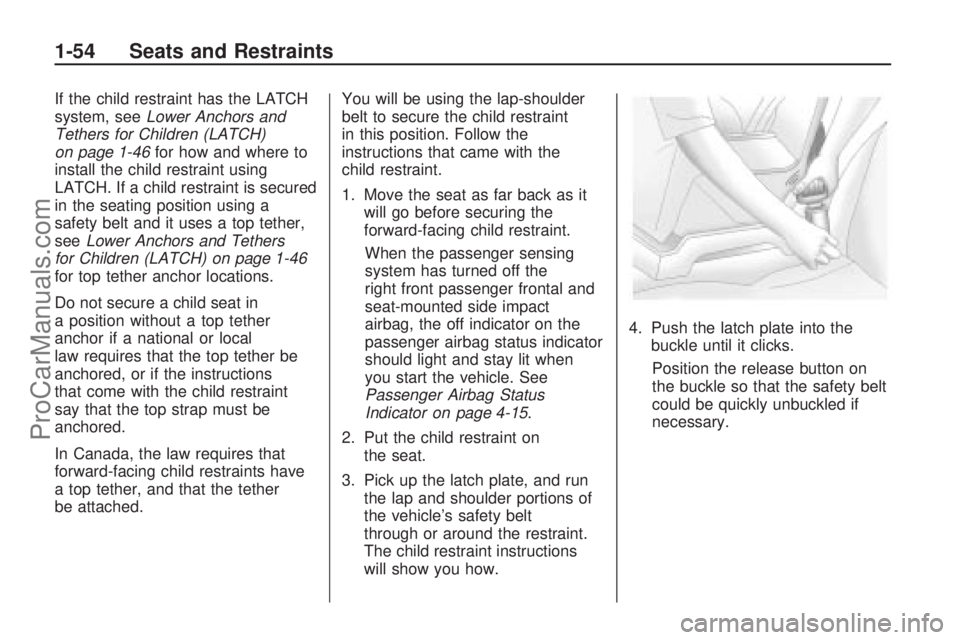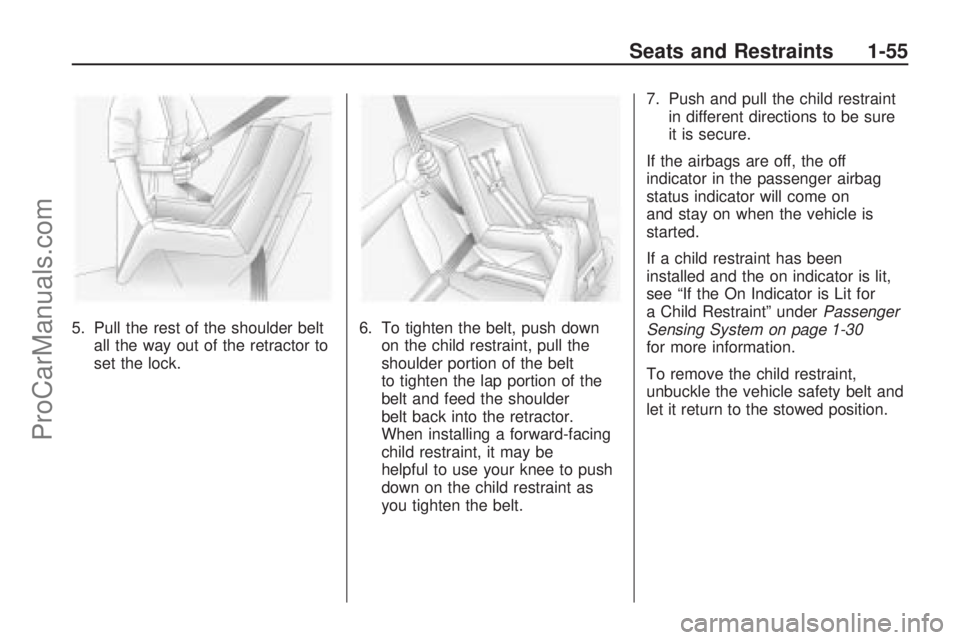2009 SATURN ASTRA airbag off
[x] Cancel search: airbag offPage 44 of 314

{CAUTION
Never do this.
Never allow a child to wear the
safety belt with the shoulder belt
behind their back. A child can be
seriously injured by not wearing
the lap-shoulder belt properly.
In a crash, the child would not be
restrained by the shoulder belt.
The child could move too far
forward increasing the chance of
head and neck injury. The child
might also slide under the lap
belt. The belt force would then be
applied right on the abdomen.
That could cause serious or fatal
injuries. The shoulder belt should
go over the shoulder and across
the chest.
Infants and Young
Children
Everyone in a vehicle needs
protection! This includes infants and
all other children. Neither the
distance traveled nor the age and
size of the traveler changes the
need, for everyone, to use safety
restraints. In fact, the law in
every state in the United States and
in every Canadian province says
children up to some age must
be restrained while in a vehicle.
{CAUTION
Children can be seriously injured
or strangled if a shoulder belt is
wrapped around their neck and
the safety belt continues to
tighten. Never leave children
unattended in a vehicle and never
allow children to play with the
safety belts.
Airbags plus lap-shoulder belts offer
protection for adults and older
children, but not for young children
and infants. Neither the vehicle’s
safety belt system nor its airbag
system is designed for them.
Every time infants and young
children ride in vehicles, they should
have the protection provided by
appropriate child restraints.
1-40 Seats and Restraints
ProCarManuals.com
Page 49 of 314

a child riding in a forward-facing child
seat; an older child riding in a booster
seat; and children, who are large
enough, using safety belts.
A label on the sun visor says, “Never
put a rear-facing child restraint in the
front.” This is because the risk to the
rear-facing child is so great, if the
airbag deploys.
{CAUTION
A child in a rear-facing child
restraint can be seriously injured or
killed if the right front passenger
airbag in�ates. This is because
the back of the rear-facing child
restraint would be very close to
the in�ating airbag. A child in a
forward-facing child restraint can
be seriously injured or killed if the
right front passenger airbag
in�ates and the passenger seat is
in a forward position.
(Continued)
CAUTION (Continued)
Even if the passenger sensing
system has turned off the right
front passenger frontal airbag, no
system is fail-safe. No one can
guarantee that an airbag will not
deploy under some unusual
circumstance, even though it is
turned off.
Secure rear-facing child
restraints in a rear seat, even if
the airbag is off. If you secure a
forward-facing child restraint in
the right front seat, always move
the front passenger seat as far
back as it will go. It is better to
secure the child restraint in a
rear seat.
SeePassenger Sensing System
on page 1-30for additional
information.When securing a child restraint in a
rear seating position, study the
instructions that came with the child
restraint to make sure it is compatible
with this vehicle.
Wherever a child restraint is
installed, be sure to secure the
child restraint properly.
Keep in mind that an unsecured child
restraint can move around in a
collision or sudden stop and injure
people in the vehicle. Be sure to
properly secure any child restraint in
the vehicle — even when no child
is in it.
Seats and Restraints 1-45
ProCarManuals.com
Page 57 of 314

Securing Child Restraints
(Right Front Seat)
This vehicle has airbags. A rear
seat is a safer place to secure
a forward-facing child restraint.
SeeWhere to Put the Restraint on
page 1-44.
In addition, the vehicle has a
passenger sensing system which is
designed to turn off the right
front passenger frontal and
seat-mounted side impact airbag
under certain conditions. See
Passenger Sensing System on
page 1-30andPassenger Airbag
Status Indicator on page 4-15
for more information, including
important safety information.A label on the sun visor says,
“Never put a rear-facing child seat
in the front.” This is because the risk
to the rear-facing child is so great,
if the airbag deploys.
{CAUTION
A child in a rear-facing child
restraint can be seriously
injured or killed if the right front
passenger airbag in�ates.
This is because the back of the
rear-facing child restraint would
be very close to the in�ating
airbag. A child in a forward-facing
child restraint can be seriously
injured or killed if the right front
passenger airbag in�ates and the
passenger seat is in a forward
position.
(Continued)
CAUTION (Continued)
Even if the passenger sensing
system has turned off the right
front passenger frontal airbag, no
system is fail-safe. No one can
guarantee that an airbag will not
deploy under some unusual
circumstance, even though it is
turned off.
Secure rear-facing child
restraints in a rear seat, even if
the airbag is off. If you secure a
forward-facing child restraint in the
right front seat, always move the
front passenger seat as far back as
it will go. It is better to secure the
child restraint in a rear seat.
SeePassenger Sensing System
on page 1-30for additional
information.
Seats and Restraints 1-53
ProCarManuals.com
Page 58 of 314

If the child restraint has the LATCH
system, seeLower Anchors and
Tethers for Children (LATCH)
on page 1-46for how and where to
install the child restraint using
LATCH. If a child restraint is secured
in the seating position using a
safety belt and it uses a top tether,
seeLower Anchors and Tethers
for Children (LATCH) on page 1-46
for top tether anchor locations.
Do not secure a child seat in
a position without a top tether
anchor if a national or local
law requires that the top tether be
anchored, or if the instructions
that come with the child restraint
say that the top strap must be
anchored.
In Canada, the law requires that
forward-facing child restraints have
a top tether, and that the tether
be attached.You will be using the lap-shoulder
belt to secure the child restraint
in this position. Follow the
instructions that came with the
child restraint.
1. Move the seat as far back as it
will go before securing the
forward-facing child restraint.
When the passenger sensing
system has turned off the
right front passenger frontal and
seat-mounted side impact
airbag, the off indicator on the
passenger airbag status indicator
should light and stay lit when
you start the vehicle. See
Passenger Airbag Status
Indicator on page 4-15.
2. Put the child restraint on
the seat.
3. Pick up the latch plate, and run
the lap and shoulder portions of
the vehicle’s safety belt
through or around the restraint.
The child restraint instructions
will show you how.4. Push the latch plate into the
buckle until it clicks.
Position the release button on
the buckle so that the safety belt
could be quickly unbuckled if
necessary.
1-54 Seats and Restraints
ProCarManuals.com
Page 59 of 314

5. Pull the rest of the shoulder belt
all the way out of the retractor to
set the lock.6. To tighten the belt, push down
on the child restraint, pull the
shoulder portion of the belt
to tighten the lap portion of the
belt and feed the shoulder
belt back into the retractor.
When installing a forward-facing
child restraint, it may be
helpful to use your knee to push
down on the child restraint as
you tighten the belt.7. Push and pull the child restraint
in different directions to be sure
it is secure.
If the airbags are off, the off
indicator in the passenger airbag
status indicator will come on
and stay on when the vehicle is
started.
If a child restraint has been
installed and the on indicator is lit,
see “If the On Indicator is Lit for
a Child Restraint” underPassenger
Sensing System on page 1-30
for more information.
To remove the child restraint,
unbuckle the vehicle safety belt and
let it return to the stowed position.
Seats and Restraints 1-55
ProCarManuals.com
Page 75 of 314

Instruments and
Controls
Instrument Panel
Overview
Instrument Panel
Overview...........................4-2
Hazard Warning Flashers. . .4-4
Horn...................................4-4
Tilt Wheel...........................4-4
Turn Signal/Multifunction
Lever................................4-4
Cruise Control....................4-5
Turn and Lane-Change
Signals.............................4-8
Headlamp High/
Low-Beam Changer..........4-8
Flash-to-Pass......................4-8
Windshield Wipers..............4-8
Windshield Washer.............4-9
Rear Window Wiper/
Washer.............................4-9
Accessory Power
Outlet(s)..........................4-10
Warning Lights, Gages,
and Indicators
Warning Lights, Gages,
and Indicators.................4-11
Instrument Panel Cluster. . .4-12
Speedometer and
Odometer........................4-13
Trip Odometer(s)...............4-13Tachometer.......................4-13
Safety Belt Reminders......4-13
Airbag Readiness Light.....4-14
Passenger Airbag Status
Indicator..........................4-15
Charging System Light......4-16
Brake System Warning
Light................................4-16
Antilock Brake System
(ABS) Warning Light.......4-17
StabiliTrak®Indicator
Light................................4-17
Engine Coolant
Temperature Warning
Light
................................4-18
Tire Pressure Light...........4-18
Malfunction
Indicator Lamp................4-18
Oil Pressure Light.............4-21
Low Oil Level Light...........4-22
Winter Driving Mode
Light................................4-22
Fog Lamp Light................4-22
Exterior Lamps Off
Reminder........................4-23
Cruise Control Light..........4-23
Highbeam On Light...........4-23
Door Ajar Light.................4-23
Service Vehicle Soon
Light................................4-23
Fuel Gage........................4-24
Low Fuel Warning Light. . . .4-24
Driver Information
Center (DIC)
Driver Information
Center (DIC)...................4-25
DIC Operation and
Displays (Uplevel DIC
and Audio)
.......................4-26
DIC Operation and
Displays (Base Level
DIC and Audio)
...............4-32
DIC Warnings and
Messages (Base and
Uplevel Systems)
............4-36
OnStar®System
OnStar®System................4-38
Instruments and Controls 4-1
ProCarManuals.com
Page 78 of 314

Hazard Warning Flashers
|
:Press this button located on
the instrument panel, to make
the front and rear turn signal lamps
�ash on and off. This warns
others that you are having trouble.
Press the button again to turn
the �ashers off.
While the hazard warning �ashers
are on, the turn signals do not work.
An indicator light on the hazard
warning �asher button comes on
whenever the ignition is turned on.
If the airbags are deployed, the
hazard warning �ashers turn
on automatically. Press the button
twice to turn them off.
Horn
Press the horn symbol in the middle
of the steering wheel to sound
the horn.
Tilt Wheel
A tilt and telescope wheel lets the
steering wheel position be adjusted.
The adjustment lever is located on
the left side of the steering column.
It allows the steering column to be
moved up or down and in or out.
Do not adjust the steering wheel
while driving.
Turn Signal/Multifunction
Lever
The lever on the left side of the
steering column includes the
following:
G:Turn and Lane-Change
Signals
2:Headlamp High/Low-Beam
Changer
J:Cruise Control (If Equipped)
Flash-to-Pass Feature.
Information for these features is on
the pages following.
4-4 Instruments and Controls
ProCarManuals.com
Page 88 of 314

Passenger Safety Belt
Reminder Light
For vehicles with this light, it
operates the same as the Safety
Belt Reminder Light except that it
is meant for the front passenger.
If the passenger safety belt is
buckled, neither the chime nor the
light comes on.
The front passenger safety belt
warning light and chime may
turn on if an object is put on the
seat such as a briefcase, handbag,
grocery bag, laptop or other
electronic device. To turn off the
warning light and or chime, remove
the object from the seat or buckle
the safety belt
Airbag Readiness Light
This light shows if there is an
electrical problem. The system
check includes the airbag sensor,
the pretensioners, the airbag
modules, the wiring and the crash
sensing and diagnostic module.
For more information on the airbag
system, seeAirbag System on
page 1-24.
This light will come on and stay on
for several seconds when the
vehicle is started. Then the light
should go out.If the airbag readiness light stays on
after the vehicle has been started
or comes on when while driving,
the airbag system may not work
properly. Have the vehicle serviced
right away.
{CAUTION
If the airbag readiness light stays
on after the vehicle is started or
comes on while driving, it means
the airbag system might not be
working properly. The airbags in
the vehicle might not in�ate in a
crash, or they could even in�ate
without a crash. To help avoid
injury, have the vehicle serviced
right away.
4-14 Instruments and Controls
ProCarManuals.com